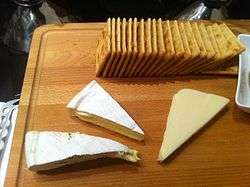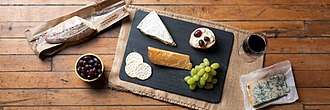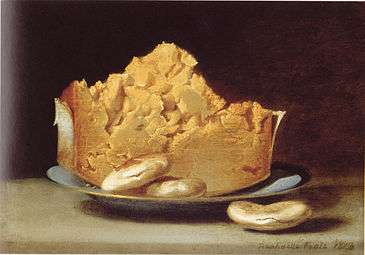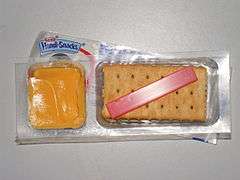Cheese and crackers
Cheese and crackers, or cheese and biscuits outside the US and Canada,[1] is a common dish consisting of crackers paired with various cheeses. Historically the fare of sailors, soldiers, and pioneers, it had become a regular menu item in American restaurants and bars by the 1850s. Many types of cheeses are used, and it is often paired with wine. Mass-produced brands of cheese and crackers include Handi-Snacks, Ritz, Jatz and Lunchables.

Overview

Cheese and crackers is a common snack food or hors d'oeuvre consisting of crackers paired with various cheeses.[2][3] In the United States it has also been served as a dessert, with the addition of ingredients such as jam, jelly, marmalade or preserves.[2] It is also commonly served at parties in the U.S., and in the Southern United States, it is relatively common for hot chili pepper jelly to be served atop cream cheese and crackers at cocktail parties.[4][5][6] Cheese and crackers has a relatively high amount of protein, per the cheese as an ingredient.[7]
Cheese and crackers is a common food-pairing that can serve to complement various cheeses, and the dish can be paired with wines.[8][9] The cheese can be sliced or cubed, and served separately with crackers or pre-placed atop the crackers.[5]
History

Cheese and crackers has been consumed by various sailors such as immigrants, whalers and explorers before refrigeration existed, using hardtack crackers and cheese.[6] It has also been consumed by various land explorers.[6]
United States

Cheese and crackers increased in popularity circa the 1850s, when bakers began producing thinner crackers with a lighter texture compared to hard tack.[6] During this time period, the combination was placed on restaurant menus as an after-dessert course and was also served in saloons.[6] Cheese and crackers was a food ration used by soldiers during the American Civil War (1861–1865).[6] Some soldiers at the time referred to cheese and crackers as a "square meal".[6][10] Cheese and hardtack was consumed along with dried venison meat by Ezra Meeker during his time on the Oregon Trail in 1852.[6] In 1915, mountaineer Philip Rogers consumed cheese and hardtack along with raisins and nuts during his expedition around Mount Rainier in Washington state.[6]
By the beginning of the 20th century, cheese and crackers was being prepared in homes and cooked by baking it and adding additional ingredients after cooking, such as paprika and mustard. At this time, the combination was sometimes served with soups and salads, and was used on salads for decades thereafter.[6] It was also commonly served at parties beginning around this time.[6] It was consumed as a dessert, rather than after-dessert by some during the Great Depression in the United States, and was sometimes consumed by President Franklin D. Roosevelt and Eleanor Roosevelt in the White House for dessert, along with other foods.[6]
Beginning in the 1950s, cheese and crackers was recommended as a snack for children by parenting experts, home economists and authors of cookbooks.[6] Consumption of the snack increased during the mid-1980s when Oscar Mayer introduced its Lunchables product, which included cheese, crackers and lunch meat, and occurred in part to boost the company's lunch meat sales.[6]
Mass production

Handi-Snacks is a mass-produced cheese and crackers snack food that is prepared using processed cheese.[12] Lunchables is another commercial product that includes cheese and crackers as ingredients.[6] Fancy cheese and crackers was a cheese and crackers lunch product purveyed by Oscar Mayer in the mid-1980s that included additional foods such as lunch meat and a dessert.[13]
In language
The term "cheese and crackers" was used as a minced oath in the United States in the 1920s (from "Jesus Christ!"), and as a slang term for testicles in the United Kingdom circa the late 1990s.[14][15] It was the catchphrase of the burlesque comic Billy Hagan.[16]
References
- Naylor, Tony (June 27, 2012). "How to eat: cheese and biscuits". The Guardian. Retrieved August 14, 2017.
- Agriculture, United States. Dept. of (1919). Farmers' Bulletin. Farmers' Bulletin. U.S. Government Printing Office. p. 1-PA59. Retrieved July 10, 2017.
- Harris, Jenn (June 23, 2016). "How to make your own next-level cheese and crackers". Los Angeles Times. Retrieved July 10, 2017.
- Neal, B. (2009). Bill Neal's Southern Cooking. University of North Carolina Press. p. 146. ISBN 978-0-8078-8958-9. Retrieved July 10, 2017.
- Crosby, Carlynn (June 27, 2017). "Five ideas for party foods to bring to your potluck". Tampa Bay Times. Retrieved July 10, 2017.
- Carroll, Abigail (September 13, 2014). "Cheese and crackers: a meal for the ages". Boston Globe. Retrieved July 10, 2017.
- Hammond, A.; Hamer, A.; Green, C.; Scott, D.L.; Pattison, D.; Bird, H.; Hurley, M. (2009). Arthritis Your Questions Answered. Q & A (DK Publishing, Inc.). DK Publishing. p. 147. ISBN 978-0-7566-5700-0. Retrieved July 10, 2017.
- Donnelly, C.; Kehler, M. (2016). The Oxford Companion to Cheese. Oxford Companions. Oxford University Press. p. 136. ISBN 978-0-19-933088-1. Retrieved July 10, 2017.
- Kennedy, K. (2010). The Art and Craft of Entertaining. Atria Books. p. 228. ISBN 978-1-4516-1260-8. Retrieved July 10, 2017.
- Mowry, W.A. (1914). Camp Life in the Civil War, Eleventh R.I. Infantry. p. 65. Retrieved August 9, 2017.
- Purvis, Jaime (July 7, 2016). "9 Nostalgic '90s Snacks We Want in Our Lunch Now". KIVI (in Kinyarwanda). Retrieved July 10, 2017.
- Prepared Foods. Gorman Publishing Company. 1988. p. 133. Retrieved July 10, 2017.
- Dalzell, T.; Victor, T. (2014). The Concise New Partridge Dictionary of Slang and Unconventional English. EBL-Schweitzer. Taylor & Francis. p. 155. ISBN 978-1-317-62512-4. Retrieved July 10, 2017.
- Dalzell, T. (2009). The Routledge Dictionary of Modern American Slang and Unconventional English. Routledge. p. 185. ISBN 978-0-415-37182-7. Retrieved July 10, 2017.
- "Billy "Cheese and Crackers" Hagan", Vaudeville Old & New: an encyclopedia of variety performances in America, Psychology Press, Vol 1., pp. 469–470, 2007, ISBN 9780415938532
Further reading
- Chaey, Christina (July 16, 2015). "Can Cheese and Crackers Be Good For You?". Bon Appetit. Retrieved July 10, 2017.CS1 maint: ref=harv (link)
- Alexander, Saffron (December 15, 2016). "The secret to perfect cheese and crackers (according to science)". The Telegraph. Retrieved July 10, 2017.